Finca: The 'Good Will Hunting' of board games
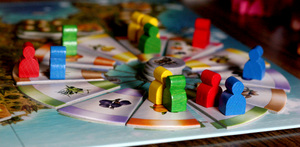
Mike Hulsebus | Contributor
Finca is a game of collecting and delivering fruit to meet the demands of the residents of of Mallorca. On paper, Finca seems a lot like last week’s game, Ticket to Ride. On a turn, players either collect colored resources or turn in a set to claim a something with those objects. But what really makes the game different is the clever way you collect those colored bits.
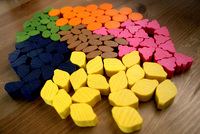
Mike Hulsebus | Contributor
Oh, the game though: right. Let’s review the game, not the pieces.
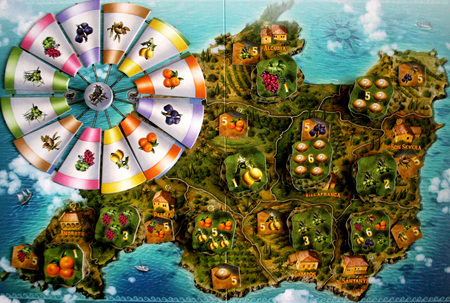
Mike Hulsebus | Contributor
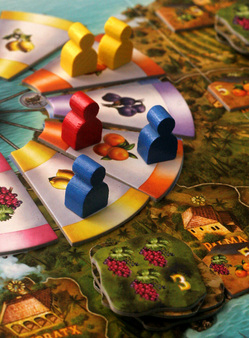
Mike Hulsebus | Contributor
It’s a simple system, but it leads to some interesting strategies. For example, if I thought that another player was trying to collect a lot of oranges and I wanted to prevent that, I could put a farmer right before the oranges. That way, if the other player gets a pawn to the space before, that pawn will have to skip over the oranges: Because would be a total of two pawns on that space (mine and his), the piece would be forced move two spaces.
Players also have to figure out which are the best pawns to move. Is it better to try and get a bunch more lemons by piling onto the space where everyone else is? Or instead should I start moving my guys off the lemon space so that people going to the space will get fewer lemons? Is it bad to move a guy one space at a time if I need a donkey or is it better to be collecting fruits? Furthermore, which fruits should I be going for right now?
To deliver fruits, you must use your turn to spend a donkey, which allows you to deliver up to six fruits to claim any number of delivery tiles. So you might spend two figs to capture a tile with two figs on it, and then claim another tile in a different community by spending its required two oranges and two almonds. Donkeys are gotten by moving past one of two lines on the windmill spaces.
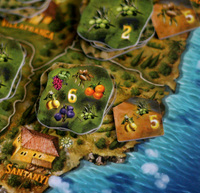
To claim this tile and the points it scores at the end of the game, a player would have to deliver a fruit of each type. Also, once this stack of tiles is depleted, the player that has the most lemons and almonds will claim the 5-point Finca tile.
Mike Hulsebus | Contributor
The first resource are the Finca tiles. When a community on the board has had all four of its delivery tiles claimed, its Finca tile gets scored. Whoever has the most of the fruit on that tile pictured on tiles he has scored so far, takes the Finca tile and the five points it offers. All scored tiles and available finca tiles are displayed openly, so players are able to strategize based on what they know other people have.
Also, each player gets four special action tiles that allow him to take special turns like moving twice or delivering 10 fruit rather than just 6. Each of these that hasn’t been used at the end of the game scores its owner two points. But, the game, in a way, is a race to deliver fruits, and so the actions that allow you to get a turn or two ahead can be worth more than the two points that they would give you at the end.
And finally, every set of tiles that a player claims (numbers 1 through 6) allows him to take a special scoring tile. The first person gets 7 extra points, and each of the remaining 3 tiles scores 1 fewer point progressively.
One other game mechanic to consider is the limited supply of fruit on the board. If there’s ever a situation where someone would have to take a certain fruit or a donkey cart and there aren’t enough for that player to take, all players must return all of that fruit to the supply and then that player takes his allotment of fruit.
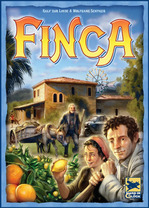
I’m excited to play Finca more, but in the end, I’m curious if the game is too balanced. No one strategy seems better suited to claim victory and the entire half-hour game (or 45-plus minutes if you're playing with more players) could be determined by who claims that game’s final Finca tile.
I don’t know if you ever played tee-ball as a kid, but I did. Young kids can’t field worth a darn and so the Little League put a limit on 5 runs scored per innings to prevent the games from going on until midnight. It wasn’t uncommon for six inning games to end up with a score of 29-30, the game decided by one inning where a team happened to magically get to three outs before the other team scored 5. You couldn’t necessarily say that one team played markedly better, but you can still point out what moments resulted in the win. And after the game everyone walked away with some improvements that they could make for next game.
I don’t mind that Finca has a sort of tee-ball feeling because, just like tee-ball was then, the act of playing the game is what makes Finca fun. While I’m going to play to win, I don’t really mind if I lose or not; I’m going to have fun either way.
Mike Hulsebus wishes that games of Finca would end with treats for all players involved. He can be reached through the comments below or at mikehulsebus@gmail.com.

